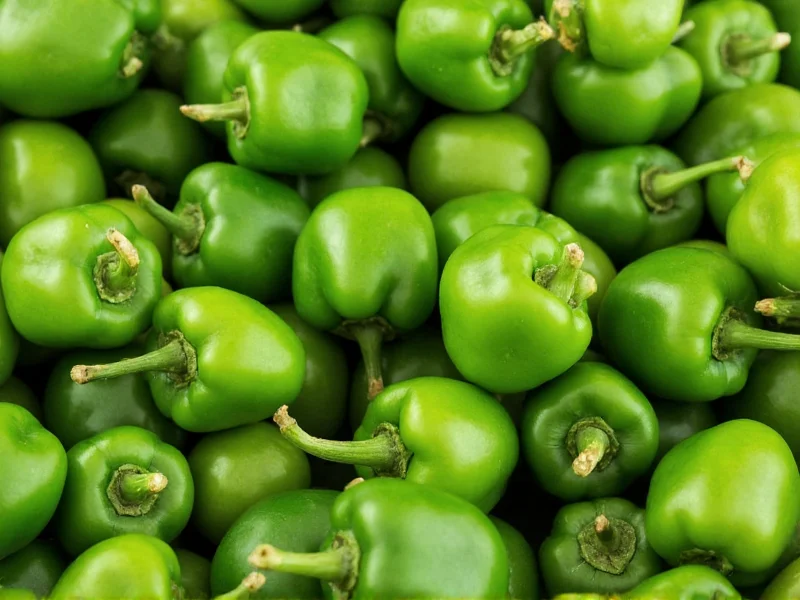Many gardeners and cooks encounter cayenne peppers in their green form and wonder about their properties compared to the familiar red version. Understanding the relationship between green and red cayenne peppers provides valuable insights for both culinary applications and gardening practices.
Understanding Cayenne Pepper Development
Cayenne peppers (Capsicum annuum) follow a natural ripening process that transforms them from green to vibrant red hues. This color change represents significant biochemical transformations within the pepper:
- Chlorophyll breakdown: As peppers mature, chlorophyll (the green pigment) breaks down
- Carotenoid development: Red pigments like capsanthin and capsorubin develop during ripening
- Capsaicin accumulation: The compound responsible for heat continues to develop throughout maturation
Contrary to common misconception, "green cayenne" isn't a separate cultivar but simply cayenne peppers harvested before full maturity. This developmental stage affects flavor profile, heat level, and culinary applications.
Green vs. Red Cayenne: Key Differences
| Characteristic | Green Cayenne Pepper | Red Cayenne Pepper |
|---|---|---|
| Maturity Stage | Unripe (early harvest) | Fully ripe |
| Flavor Profile | Grassy, vegetal, slightly bitter | Sweeter, fruitier, more complex |
| Heat Level (Scoville) | 30,000-40,000 SHU (slightly milder) | 30,000-50,000 SHU (peak heat) |
| Texture | Firmer, denser flesh | Softer, thinner walls |
| Common Culinary Uses | Stir-fries, pickling, fresh salsas | Drying, powdering, cooked sauces |
Culinary Applications of Green Cayenne Peppers
Chefs and home cooks can leverage green cayenne peppers in specific applications where their unique properties shine:
Fresh Preparations
The firm texture of green cayenne peppers makes them ideal for fresh applications. Many Southeast Asian and Caribbean cuisines feature green cayenne in:
- Raw salsas and chutneys where the grassy notes complement other fresh ingredients
- Stir-fries where they maintain structure during quick cooking
- Pickled preparations that preserve their crisp texture
Flavor Development Considerations
When cooking with green cayenne peppers, understanding their flavor evolution is crucial. Unlike red cayenne which develops sweeter notes when cooked, green cayenne maintains more of its vegetal character. For recipes specifically calling for green cayenne pepper heat level, consider these tips:
- Add toward the end of cooking to preserve fresh flavor
- Pair with acidic ingredients like lime juice to balance bitterness
- Use in dishes with complementary vegetal notes (asparagus, green beans, peas)
Growing and Harvesting Green Cayenne Peppers
Gardeners interested in harvesting cayenne peppers at the green stage should understand the optimal timing and techniques:
Harvest Timing
Green cayenne peppers typically reach harvestable size 60-70 days after transplanting, while full red maturity requires 80-100 days. Key indicators for harvesting green cayenne include:
- Firmness: Peppers should feel solid with taut skin
- Size: Typically 4-6 inches long for most varieties
- Glossiness: Healthy green cayenne peppers have a shiny appearance
Growing Conditions Impact
Environmental factors significantly affect green cayenne pepper development:
- Temperature: Consistent warmth (70-85°F) promotes steady growth
- Watering: Even moisture prevents stress that can cause premature ripening
- Soil nutrition: Balanced fertilization supports healthy development without accelerating ripening
Common Misconceptions About Green Cayenne
Several misunderstandings surround green cayenne peppers that deserve clarification:
"Green Cayenne" as a Variety
No distinct "green cayenne" variety exists in botanical terms. All cayenne peppers pass through a green stage. Some seed catalogs may list "green cayenne" but this refers to harvesting practices, not genetics.
Heat Level Myths
Contrary to popular belief, green cayenne peppers aren't significantly milder than their red counterparts. While capsaicin continues developing during ripening, the difference between green and fully red cayenne is relatively modest compared to the natural variation within the species.
Confusion with Other Peppers
Green cayenne is sometimes mistaken for:
- Green jalapeños (shorter, thicker, milder)
- Green serranos (smaller, hotter)
- Unripe bell peppers (completely different species, no heat)
Storage and Preservation Techniques
Proper handling maintains the quality of green cayenne peppers:
Short-Term Storage
For immediate use (1-2 weeks):
- Refrigerate in the crisper drawer in a paper bag
- Avoid washing until ready to use
- Store away from ethylene-producing fruits like bananas
Long-Term Preservation
Green cayenne peppers preserve well through several methods:
- Pickling: Maintains crisp texture and fresh flavor
- Freezing: Blanch briefly before freezing for best results
- Drying: Possible but less common than with red cayenne
When to Choose Green Over Red Cayenne
Selecting between green and red cayenne depends on your culinary goals:
- Choose green cayenne when you want a fresher, grassier flavor profile
- Opt for green cayenne in dishes where pepper texture matters (stir-fries, fresh salsas)
- Use red cayenne for dried applications, powders, or when sweeter heat is desired
- Consider green cayenne for pickling projects where color contrast is appealing
Understanding the natural progression from green to red cayenne peppers empowers both gardeners and cooks to make informed decisions about harvesting, usage, and substitution. Whether you're growing your own or selecting peppers at the market, recognizing that green cayenne represents an early developmental stage rather than a distinct variety helps optimize your culinary results.











 浙公网安备
33010002000092号
浙公网安备
33010002000092号 浙B2-20120091-4
浙B2-20120091-4